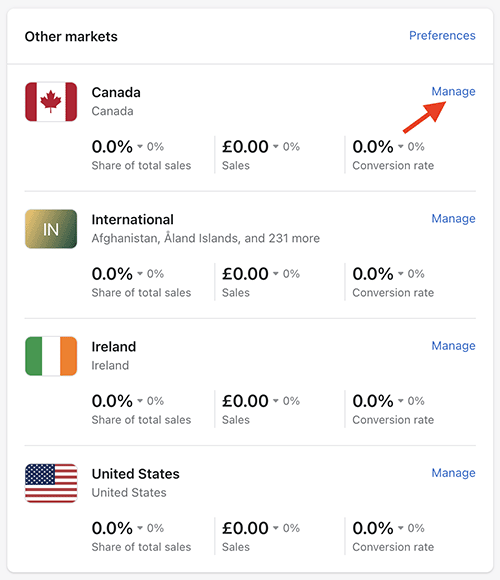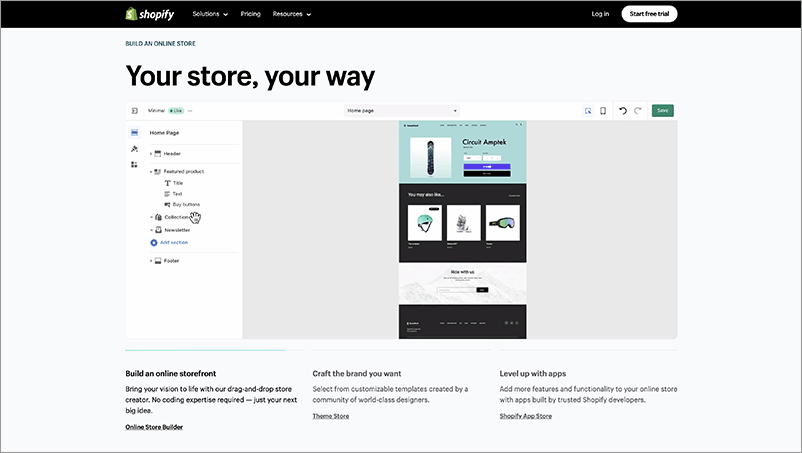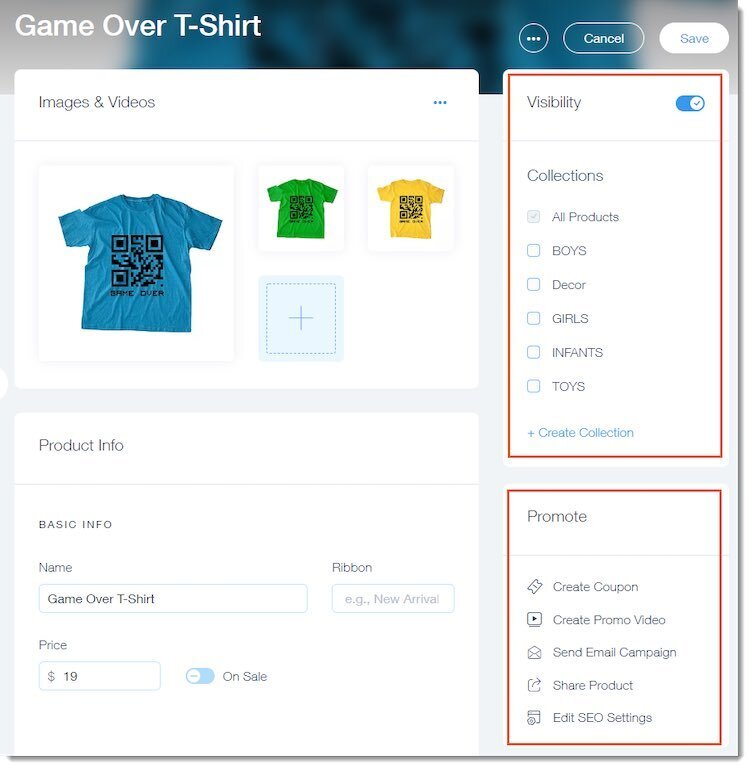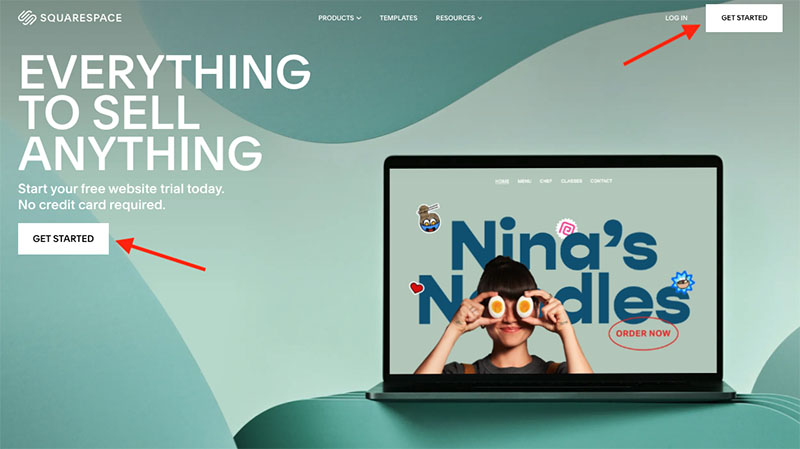Our content is impartial, but funded in part by affiliate commissions (at no extra cost to our readers). Learn more.

Whether you’re a small business looking to take the first steps into selling online, or an established brand aiming for a fresh look, choosing the right ecommerce platform can be hard. But don’t worry, you’ve come to the right place!
We’ve compared three hosted platforms that most people use to build an online store — Shopify, Wix, and Squarespace. All are designed with web design newbies in mind, and none require coding skills. Read on to discover which one is right for you.
The quick take

Shopify
Of the three platforms, Shopify is the most powerful from an ecommerce point of view, giving you outstanding features for selling internationally, in physical locations or via dropshipping. It’s definitely the most scalable of the three too.

Wix
Wix offers a nice mix of content management tools, ecommerce tools and marketing tools at a lower price point than Shopify. It also gives you a huge range of templates to choose from. It’s a good all rounder that gives you a lot of bang for your buck.

Squarespace
With its stunning templates and highly flexible approach to content management, Squarespace is a good choice for sites involving creative projects (music, art, photography etc.). It’s also particularly suited to those wishing to sell online courses.
The deeper dive
Shopify — the go-to solution for serious sellers
Of the three products being discussed, Shopify is the only one that started out as a dedicated ecommerce platform — the other two are website building tools that gradually introduced online selling features over time.
As you might expect then, Shopify’s ecommerce features are by far the most developed and sophisticated of the three platforms — especially where international selling, dropshipping and in-person selling are concerned.
Unlike Wix and Squarespace, Shopify offers true end-to-end multicurrency transactions; the range of dropshipping apps it provides is significantly larger than the Wix and Squarespace offerings; and its point-of-sale technology (which lets you sell in a physical location like a retail outlet, market stall or pop-up shop) is more extensive and more advanced.

Another standout feature of Shopify is its abandoned cart saving features; they are extremely sophisticated and bundled with nearly all its plans.
And, it’s worth noting that as your ecommerce business develops, Shopify’s enterprise grade edition — Shopify Plus — can truly handle growth and significant scaling. Similarly, the huge range of apps available for Shopify (8,000+) mean that you can develop the platform in any way you like or integrate it with a host of important third party services. Wix and Squarespace don’t give you nearly as much ‘extensibility’ or ‘scalability’.
Shopify fares less well than the other two platforms when it comes to design flexibility however — it offers you a smaller range of free themes, and while professional in appearance, these templates are a bit harder to customize than Wix’s or Squarespace’s.
But overall, it’s hard not to view Shopify as the most sophisticated and scalable of the three products, and you can access a free trial of the platform here.
Tip: you can save on Shopify by using this special link. It gives you a free trial followed by access to the platform for 3 months for just $1 per month.
Wix — a good all-rounder
Wix is a good all-rounder. The main reason to use the platform is that it gives you a lot of value for money — for a fairly low monthly fee, it lets you build a site that includes an online store, a blog, galleries, appointment booking and more (you also get email marketing tools as part of your subscription too).
Thanks to its ‘video hours’ feature, it’s a good option for selling video content; and it lets you translate one store into over hundred languages without any additional costs being involved, making it a potentially good fit for users on a budget who want to sell in lots of different countries.
Wix’s drag and drop editor is more flexible than Shopify’s — you have huge control over how your site looks on both desktop and mobile — and its blogging tools are a bit more sophisticated too (because they let you categorize content in more way, and feature auto-save and backup features).
Key things to watch out for with Wix however are its underpowered multicurrency features (while it lets you display prices in lots of different currencies, the checkout process only supports one) and the way that it doesn’t let you switch templates once you’ve picked one.
Additionally, its templates aren’t fully responsive, meaning that you may need to tweak the mobile version of your site a bit more than you’d like to get it to appear the way you want it to (responsive templates reformat themselves automatically to suit all device types).
Overall though, Wix is a good choice for those on a low budget who have simple needs and want a lot of control over how their site appears.
Squarespace — the site builder for creatives
If design aesthetics are your thing, there’s a lot to be said for using Squarespace. Its templates are superb, and the tools it gives you for laying out content in an attractive way are brilliant. Of the three platforms, it’s arguably the easiest to use too.

Its selling tools are a bit more basic than those provided by Wix and Shopify — particularly where in-person selling (point of sale) is concerned. But the tools it does give you are very easy to get started with.
Squarespace is often a good choice for users who want to sell courses and gated content on their site. Its ‘Courses’ and ‘Membership Sites’ features are great for that (although note that you will need to pay extra to access these features).

Squarespace is not the best choice for international selling however — it doesn’t boast any multi-currency selling features and translating a Squarespace site into multiple versions involves using expensive add-ons.
We typically recommend Squarespace as a good solution for ‘creative’ users like musicians, artists and photographers, who value top-class aesthetics and want some simple selling features on the side. It’s also a good choice for those who wish to monetise their content via selling online courses.
Tip: how to save on Squarespace
To get 10% off a Squarespace plan, do this:
- Sign up for a free trial using this special link.
- Use the discount code STYLEFACTORY10 when subscribing to a plan.
Summing up
For serious ecommerce projects, choose Shopify. It’s by far the most feature-packed hosted solution for selling online, and a cut above Wix and Squarespace in nearly all ecommerce respects. If you envisage growing your project from a side hustle into a serious business, Shopify is the best option.
For portfolio sites or sites involving creative pursuits (music, arts, photography etc.), Squarespace is a good choice. Its templates are superb and its ecommerce tools are great for simple selling. And if selling online courses is your main focus, it gives you a really easy way to get started with that.
If you need a strong mix of content management features and ecommerce tools, choose Wix. It offers a wide range of content creation tools and an ecommerce tool set that is more developed than Squarespace’s. In short, it’s a good all rounder that offers decent bang for the buck.
Free trials
All these platforms can be tried for free — so why not try all of them? That’s the best way to get a sense of which one is right for you.
Style Factory is a leading provider of impartial, expert ecommerce advice.
Website terms and conditions | Privacy policy | Cookie notice





